
PICO: Practical Enterprise Applications in XR at Scale
- January 30, 2024
Listen and Subscribe on Your Favorite Platform:
Episode Summary
Join us in an insightful episode of XR Industry Leaders with Amir Khorram, General Manager of PICO North America. With a rich background in optics, photonics, and major XR hardware companies, Amir brings a unique perspective to the table, one shaped by his experiences at HTC and now PICO.
In this episode, we delve deep into PICO’s commitment to enterprise solutions and their partner-first approach, a strategy that distinguishes them in the XR landscape. Amir discusses how PICO has always been enterprise-focused, particularly in North America, prioritizing partnerships and collaborative solutions over a solitary, closed-off approach. He highlights PICO’s dedication to being an integral part of the ecosystem, fostering growth and innovation alongside partners like ArborXR, XR Health, and Striver, among others.
We explore the significant shifts in the XR industry, touching on its rapid evolution and the growing demand for scalability and versatility in enterprise solutions. Amir shares insights on the challenges of scalability, device availability, and the continuous quest for innovative applications that can leverage XR technologies in diverse sectors like education, healthcare, and corporate training.
Reflecting on personal interests, Amir reveals his fascination with enterprise use cases in XR, from training doctors and pilots to immersive educational experiences. His enthusiasm for the myriad ways XR technology is revolutionizing industries is palpable and infectious.
Amir also shares his vision for the future – a world where XR devices are as ubiquitous as PCs, creating a one-to-one ratio in enterprises and educational institutions. It’s a forward-looking perspective, hinting at a future where XR is integral to every aspect of our professional and educational lives. Join us in this engaging discussion that not only sheds light on the current state of XR but also gives us a glimpse into its exciting future.
Key Moments
- Singular focus on enterprise (02:50)
- Social media company’s connection to VR (04:53)
- What industries are seeing the most movement in VR? (06:30)
- Signs of adoption and exponential growth for XR (10:00)
- Open ecosystems in XR (13:30)
About the Guest
Over an 18-year career, Amir Khorram has played key roles in the launch and scale of cutting-edge technology. From 5G cloud collaboration to XR, Amir has built business units that have led enterprise growth. Amir now leads PICO North America, delivering world-class VR solutions to everyone from SMBs to Fortune 500 organizations.
Links and Resources
Learn more about getting started with XR in our ultimate guide to managing VR training for work.
Episode Transcript
Brad Scoggin: Hey there, welcome to “XR Industry Leaders” with ArborXR. My name is Brad Scoggin, and I am the CEO and one of three co-founders of ArborXR. And we’ve had the opportunity of working with thousands of companies since 2016, and we’ve learned a ton about what it takes for XR to be successful in your organization.
Will Stackable: And I’m Will Stackable, co-founder and CMO. This podcast is all about interviewing the leaders who are on the ground making XR happen today. True pioneers in the space from Amazon, Walmart, and UPS to Koch, Pfizer, and beyond to uncover the pitfalls, lessons learned, and secrets that you can use to help grow XR in your organization.
Brad Scoggin: Well, this week, we get to sit down with Amir Coram, the GM of Pico North America. Amir, it’s great to have you on the show.
Amir Khorram: Appreciate it. Thanks, gentlemen, for having me.
Brad Scoggin: And I guess we’ve gotten to know each other over the last year or so since you’ve been at Pico, but you’ve been in XR for a while. We’d love to hear a little bit about your journey into XR and how you’ve ended up in the current role that you’re in.
Amir Khorram: Thanks. Yeah, and I feel like a lot of people in this space have had unique paths to get to where they get to where they’re today in the XR space. I actually started off in this industry in the software space, working for a company that specialized in optics and photonics and was actually kind of the default software that a lot of the VR companies used to design their lenses. So pancake lenses, testing light, how those types of interactions pass through the headsets. I spent a few years there, started to get introduced to and understand the VR and AR space, and eventually got an opportunity to join one of the major hardware companies in the XR space in HTC. I actually spent a great few years there working with them and got a chance to kind of grow the enterprise side of the business with the team over at HT C and then eventually got an opportunity to move over to Pico, which is where I’m now and leading the B2B side here in North America.
Brad Scoggin: I love that. And I feel like a million questions and different ways I want to go. I think sometimes Will and I talk about how we feel like at Arbor we have a fairly unique perspective on the industry just because where we sit. I think you have an equally interesting and unique perspective. Maybe start with just, I think one of the things we really like about PICO is the commitment to enterprise. And so maybe start there just kind of how you all have differentiated yourself in the enterprise space.
Amir Khorram: Sure, sure. And I love having this conversation because I think as the awareness for VR grows both on the consumer and on the enterprise side, we get asked that a lot. It’s like, why is PICO the right solution for businesses, for organizations? And I think it all starts with the fact that Pico really originated as an enterprise solution, especially in North America. It’s always been an enterprise solution. It’s not the type of approach that we took where we said, Hey, let’s start with consumer. Then we realized that organizations can also use this. We built the hardware, the backbone, the ecosystem, and our partnerships with an enterprise-first approach. So really, everything from our early three do headsets and the G two, G two 4K series to the neo threes. And then, today, with the PICO4E, we’ve always been leading the way for the enterprise here in North America.
And I’d say one of the key approaches for us has also been, and you mentioned this, and this is why I’m really happy to be on this conversation with you guys, is it’s really been a partner-first approach for us. It’s really been about how Pico can grow in the market, globally, and in various verticals and industries with our partners. We’ve never tried to go at these things alone. So it’s been really looking at how we grow with Arbor. How do we go and find new opportunities and new ways to solve problems in various industries? How do we collaborate with some of the best developers in the industry to deliver solutions in healthcare and education, corporate training, lbe, or whatever that is? And so I think taking that partner-first approach has also been a real emphasis and stamp for what we’re trying to solve in the enterprise.
Brad Scoggin: Yeah, I like that a lot. I think just the openness too. I mean I think that was very early on. I think that’s what stood out to us and to a lot of our customers was your openness. I’m curious, it’s interesting, I dunno if anybody would’ve predicted that two of the biggest headset companies would have such close ties to social media companies. It’s kind of interesting way things have played out. So just curious how you think about that, the social media connection, but also with Meta’s recent resurgence, I guess, or recommitment to enterprise, how you think about that as well.
Amir Khorram: Yeah, there’s a few different approaches, or I guess, ways we could start that conversation. And I think in Arbor, I think in Pico, we have many mutual customers who have bought into their commitments to the enterprise and maybe come away a little unhappy with the experience or wondering what happened and why their focus shifted back to the consumer. That’s maybe another conversation for another day, but I think your point is correct. And we have, again in Pico, been in a unique situation in that PICO was operating here in North America for almost a decade, really growing a business globally actually, and now being part of Bytedance. I think it’s given the organization a really exciting injection of just creativity, people, and resources that can help Pego continue to grow and scale and be a really creative and innovative solution in the enterprise. I think it is unique that Quest is connected to meta Facebook and social media, and we’re part of a really big and exciting company here as well. And I think it really positions us well for some exciting chapters ahead for Pico.
Brad Scoggin: Yeah, absolutely. And curious just from an industry perspective, I think we have to guess from our perspective. So we’ve been in VR since 2016, and we started in LBE; we started back when it was all HTC vibes. And so we’ve kind of just grown with the industry and saw some early attempts for companies to push into enterprise or education. It really wasn’t until the cord got cut that it started becoming possible over the last few years. But I would say from our perspective in the last 18 months, 12 months, six months, it feels like, well, feels like in what we’re observing is there’s just a heating up in the enterprise. And I think we use the word enterprise very loosely, like anything that’s not consumer, pretty much. But just curious from your perspective; I mean, what are you seeing? Are you seeing any specific industries that are feeling hotter than others?
Amir Khorram: It’s a good point. And it’s funny you mentioned the point about the all-encompassing enterprise term, right? I always feel bad using the term enterprise in education because I don’t think schools really consider themselves enterprises, but that is kind of how we separate things. It’s not really a consumer solution, it’s really just everything else. Business, enterprise, education. I think education is the first one that comes to mind. I think the growth that we saw going into the global pandemic was really positive and unique, and we were starting to see schools invest in technology and different ways to teach students. And then I think when the whole world shut down and all these things started going on, we started to see the education vertical specifically really rush to solve how do we continue to teach kids and deliver curriculum and deliver content?
And we all know, or all had grade schoolers trying to stay focused on Zoom calls for seven hours a day, not happening. And we saw that in the corporate world as well. So I’d say education is one that has really a rocket ship really started to grow over the last two, or three years. Healthcare is one as well, right? Healthcare is one where for both individual use cases and then also through employers, there’s opportunities to really provide mental health, physical health, and rehabilitation services in an XR manner, whether it’s through vr, ar, and all those different solutions. Corporate training has been consistent. Corporate training has been a consistent growth point. Organizations that have the budget, that have the time have the resources are certainly looking at how to continue to grow, retain, train, and improve the quality of their teams and just their knowledge of what they’re doing every day. So I’d say those three spaces I think, are pretty consistently growing and I see a very bright future there. I think the last one for me at least, would be LBE is always an exciting space. They were always the early adopters in VR and innovative ways to interact and deliver content. And I think we’ve seen a resurgence in LBE as well a few years out from the pandemic. Again, I think there was definitely some retraction and maybe some consolidation, and now we’re starting to see some really healthy growth there.
Brad Scoggin: Yep, yep. Oh, man. LBE days. We talk about it a lot. I think one of the things that gets us most excited about XR outside of the consumer space is, I mean, we say it’s a learning revolution. And so learning is training. Learning is even in healthcare. I think a lot of the healthcare applications are just changing the way you think. But I think it’s really powerful, and it’s really exciting to see what’s happening across multiple verticals. And I think from our perspective, while maybe, as you said, there are buckets, whether it’s education or training, that are heating up within training, what we’ve seen is it’s not necessarily specific to a specific industry. It still feels to us that it’s just whichever company had the most forward-thinking l and d department. Because we’ve got giant retail companies that are five years in, and we have giant retail companies who just started training the exact same workforce, and we see
Amir Khorram: Couldn’t agree more.
Brad Scoggin: So I think that’s really interesting. And it’s also, it’s encouraging to me because you have some of these leading companies, biggest companies in the world who are deep into it, who have proven it, and it’s like we’re early, right? There’s still so many companies in those same spaces that should come behind them and continue to grow. And I think what we’ve seen too in the last 12 months, six months, three months, just I mean, an increase in signups and increase in conversion. And we like to think part of that’s because we’re doing a better job as a company. But I think a big part of it’s just the industry’s growing more companies from around the world, different industries, industry. I don’t know if you know this number in my notes here. We have almost a thousand organizations in Arbor that are using Pico, which that’s a big number.
Amir Khorram: That is a big number, absolutely. I think that’s really exciting to hear, and I think it speaks to our really strong collaboration over the last several years. I think it’s one of those things where we know in the enterprise that serious enterprise deployments are better with PICO and with Arbor. And just putting those two things together and our relationship together has only proved that.
Brad Scoggin: And last thing I’ll say, I know Will has a question, so I want to think, I think the other thing that’s really encouraging that we’re seeing across the board, and I’m sure you’re seeing this as well, is every one of the accounts on our platform, they’re adding headsets, they’re all growing. So I think that’s another thing is we’re early, we’re seeing all industries starting to get into XR at different levels, and then everyone that once they get in there is exponential growth. So it feels like the future is very, very bright. Sorry, will I know a question?
Will Stackable: No, I was actually going to kind of segue on what you just shared, Brad. I think we’re seeing a number of organizations that have done successful pilots, and they’re now asking the questions about, okay, as we go to scale, big Fortune 500 companies that have been in the pilot stage for a few years, they’re looking to scale, and they’re asking questions about what hardware should we use, what management software should we use? So something I wanted to pick your brain on, we oftentimes see companies early on, buy whatever had set off the shelf, which, if it was in the last five years, likely they went to Best Buy and bought a Quest headset. Now they’re thinking about scale, and they’re asking different questions. One of the things across that thousand organization spectrum, one of the things we hear regularly, is this concern about being in a closed ecosystem. And I think a lot of companies want to feel like there’s more, that they’re in an open ecosystem, that they have more options. Talk a little bit about that, and how did Pico land on the other side of that? If Pico’s, sorry, meta is on the far end of the closed ecosystem. How have you guys landed on being more open, and what does that look like for an enterprise customer?
Brad Scoggin: Well, and with one comment, one comment, just I think what we see, we all see it. There’s such a temptation to go closed, ecosystem. Investors want everyone wants to go close. So just add as you answer the question through that lens as well, avoiding that temptation.
Amir Khorram: No, that’s a good point. And to your point, absolutely, I think most companies wouldn’t mind being Apple, right? I mean, you look at their growth, their success. If you look at their balance sheet, I don’t think anybody would walk away from an opportunity to be Apple. And I think some of these things certainly predate me as far as Pico’s culture and their approach to being an open ecosystem. I think it can also relate to the company itself. Just seeing how trying to do things alone is often the most challenging way of going forward, especially in an industry where it’s constantly about innovation, early adopters, carving out new paths, and proving new solutions. You look at healthcare, and I mean, I like to remind people this, we are not healthcare experts at Pico, right? But we work with some amazing healthcare professionals and healthcare experts, whether it’s in higher education at some of the biggest universities in the world, major hospital systems developers out there like XR, health of the World, Applied VR, all these different amazing healthcare developers and in the classroom the same thing.
So I think to your point, we’ve seen that we typically are able to really just provide the best solutions when we go at it with partners. I think our partners look at it and say, and sometimes they look at it too and scratch their heads and say, wow, FICO is not trying to do this themselves. They’re recommending Arbor, they’re recommending this developer, that developer, and they’re just bringing everyone together, I think, which is oftentimes a great approach. And the end users appreciate that more as well, versus us coming to the table and saying, we’ve got everything for you. We’ll build the software, we’ll provide the content management, the hardware management, all that sort of stuff. I think going at it in a collaborative way sometimes creates just more sense of trust and assurance that we’re just, we’re not bringing them into a room locking the door saying, we’ve got everything you need here.
It’s like, no, let’s have an open discussion. Let’s bring everyone to the table. Let’s identify really what is needed here and how we can all work together to solve that. But you’re right. I mean, a lot of other companies take this closed-off approach, and I don’t know if that’s out of fear of losing the customer, or sharing the customer with other people. That’s not on our minds. Our mind is, we’re always looking at if Arbor can become the biggest, most successful company at what they do, that’s good for us. If Prisms or XR Health or all these different companies that we work with, developers that we work with striver of Roundtable of Pix, these companies can become the biggest, most successful developers in VR in the world. That’s good for us too. So we’re not trying to replace them. We want to support their growth, and we want to be a part of it. We want to be along for the ride
Will Stackable: Well, I love that. I think we felt that working with your team, and when we talk to enterprise customers, I think everyone wants to feel like they have control over their own features. And if you go out and buy laptops for your employees, you want to be able to install what apps you want to on those, and you want to be able to manage those laptops however you want to manage them. And the last thing you want is for somebody to pull support for your laptop a year down the road, and now you have bricked laptops. So I think there is sort of a desire for the flexibility and control and just future stability that comes with a more open ecosystem. And I’ll just say this, if you want to take the Apple route, you’ve got a full-on, go the Apple route and take it to a hundred percent. And not everybody can do that.
Brad Scoggin: Well, actually, nobody can do that. Everyone wants to do that. There’s one company in the world’s industry who has done it. One,
Amir Khorram: You can’t straddle the fence there exactly. Either you’re going to go full close off ecosystem and we’ll deliver every solution you want now or could ever need in the future. Or you better build a healthy ecosystem of partners to go deliver the same solutions. And that’s the approach we’ve always taken. And I feel like, are we doing everything perfectly? No, I don’t think we’re, but I think one of the most important things that we do here, and I consistently see the other companies are not doing in the hardware space, is they’re not actually just talking to the customers and developers and listening and saying, what isn’t working? Great point. Why isn’t it working? And how can we fix that? I don’t see that happening elsewhere, and I know that because the end users and the developers will consistently say, wow, it’s really nice. It’s refreshing to have somebody ask us what’s not working and work with us on a solution versus saying, here’s the package solution that we’re pretty sure will work for you. Here’s the self-help link. Go read through that and find the answer yourself. Here’s our generic support inbox. Just load a blind email into this inbox, and someone will get back to you in 72 hours. That’s not how we operate. People, developers, partners, and users in North America, know the team at Pico; they know our faces, they know our cell phone numbers, and they know our email addresses because they talk to us consistently. And I think that’s a major differentiator for us. Well,
Brad Scoggin: It’s very refreshing, and I think having been in XR just in tech for seven years now, it’s still several things that are shocking to me. One, the number of people or companies who still think they can do everything, but two, the number of companies who don’t talk to the customer, it honestly is mind-boggling to me. You see offerings or solutions brought to market, and you’re just thinking they haven’t asked a single person. There’s no way anybody either wants that or wants to pay that or can pay that. It’s just shocking sometimes to me. Yeah. So I think the approach that you’re taking is very refreshing, but I think it’s also, I mean, the XR industry is evolving so rapidly, just even from a content perspective. I mean, we’ve got major customers who have gone from outsourcing to acquiring content studios to a mix, to authoring tools and try for anyone this early in the game, I think to come in and say, we’re going to be the shop. It feels, I just don’t know if it’s possible. There’s just so many varying needs that are evolving rapidly.
Amir Khorram: Totally agree. It’s such a fast-evolving industry, and even talking about something that happened or something we heard or said or deployed six months ago, it feels like a lifetime ago. So even just thinking back to CES this year, that was this year, but it feels like it was about 10 years ago, right? Yeah, exactly. So I mean, just this industry and things that are changing, evolving and demands and solutions that are out in the marketplace, you got to listen. You got to be nimble.
Will Stackable: Well, let’s talk about that. What are some of the lessons you’re learning as you’re talking to customers on the ground? What are you hearing in terms of major pain points, and friction points that still exist, and how are you trying to solve them?
Amir Khorram: Yeah, that’s great. So I mean, I’d say there’s, I think the questions, the pain points, those also continue to evolve, right? Because I think two or three years ago, the pain points that maybe we were seeing in the marketplace were, what can VR do for me? Why would I want to invest in VR or ar, any type of XR solution? And maybe it’s getting a handful of headsets, then all of a sudden realizing if I want to go from five to 500, what does that take? We’re starting to see, I think the marketplace has certainly evolved in this understanding of the solutions available, the different types of content that could be out there for ’em. So I’d say now it’s really, and I hate to use just this kind of a cliche term, but it’s very much scalability right now, and you were talking about this earlier, Brad, it’s like a lot of those POCs, those big POCs have run their course, and companies have bought in, and they’re investing, and now they’re looking at scalability.
They’re certainly looking at availability. If I want 10,000 headsets, how quickly can I get those? And I think it’s also really, we’re at that point now where companies are saying, what else can I do with the headset? Which is a great thing for all of us when they acquired those headsets in the hundreds or in the thousands to provide a training solution for their employees or to provide a wellness solution for patients. Now they’re thinking, well, we’ve got these headsets in place, we’ve got our content management, hardware management place. What else can we do with this portal, with this solution, with this technology? And that’s exciting because now we’re starting to think, how can we start to turn the headset almost into a MacBook or a Windows computer? How can we provide a solution where they can do more than one thing where they can start to use it maybe multiple times a day, maybe multiple hours a day, whether it’s in the classroom or at home or in the office. So I think where we’re starting to get to that point is how do we now connect the dots between these different amazing solutions that are on the marketplace, these training solutions on one side, these mental health and wellness or physical fitness or gaming or social applications that are on the other side, and how do we connect the dots and start to really bring those things together? So I know we always say this, we’re still very early in this industry, and we’re right. We’ve come a long way in 5, 6, 7, 8 years, but we’re still so early in this space, and we’re still now trying to figure out how do we bring these different types of applications together into a solution that people can use and benefit from on a more regular basis than just a one app, one app launch point.
Brad Scoggin: Yeah, I love that. And it is this weird of we’re early, but at the same time, to your point, I think moving past the question of either how do I use XR or Will XR work, which I think we passed that maybe 12 months ago, 18 months ago, maybe 12 months ago, broadly speaking, that’s a huge step because now we can start to all think about to your point, okay, now we know it works. Okay, awesome. So what are all the ways we can use it? How do we use it multiple times a day? How do we get more use out of the device? What other types of content? And that to me is just a huge inflection point for the industry. But then you do look at the numbers out there and you think, wow, there’s so much growth potential, so much growth potential, which is equally exciting.
So it’s like we’ve gotten far enough, and I don’t know when you meet reach critical mass or tipping point or whatever, but it feels like we’re getting somewhat close to that, at least in some ways. But yet, there’s just still so much, so much ahead. Okay, I’ve got then maybe we will head towards a wrap here. I’ve got two kind of forward looking questions for you. One is your perspective as a representative of pico, and then one is your perspective as Amir, a person, a man. So on the business side, just curious your take on, do we go one-to-one in enterprise or in education at some point, and how far out is that?
Amir Khorram: That’s a great point. So early on in my career, I remember working for a small startup, and I remember the founder of the start of telling me stories of the days when they first started to deploy PCs into organizations. And he would tell me about how they would literally have a computer, and now this predates me, I’m definitely not this old, but they would put computers on carts and roll them around the office, and if somebody needed to type something, they would go grab the computer and roll it to their desk and whatever, work on their Word documents, whatever that may be. And then they’d roll it back and people would share computers across the offices across different floors. And now that sounds ridiculous. We all have a MacBook, a Windows pc, whatever that is on our desk, maybe also a smartphone and a tablet and a VR headset nearby.
And I think we’re still kind of at that point where companies are sharing maybe 50 headsets among a thousand employees, or they’re sharing 5,000 headsets among a hundred thousand employees. But I think we’re getting to that point. We’re working our way. We’re chipping away in that direction of a one-to-one ratio where everyone will have a headset. And I think that comes from a lot of different angles. It comes from the content continuing to evolve. It comes from the hardware and the tech continuing to get lighter and smaller and more easily just carried around. And then it comes from just the systems and the backend and it part of it and everything being connected and managed in one consistent ecosystem. So certainly we’re headed there, right? We’re definitely headed there. We don’t have, I think we’re past the point of maybe a hundred people sharing a headset, but we’re certainly not at the one-to-one point yet as well. But I’m really confident in the direction that we’re heading there.
Brad Scoggin: Yeah. Yeah, it’s exciting. I mean, I almost don’t even let my mind go to that because those numbers get so big. It’s like, okay, if we’re in a 20 to one or 10 to one user to headset ratio, those numbers aren’t small. That’s exciting. No, but it is interesting to think about a world where it’s a one-to-one. But yeah, like you said, there’s plenty of examples, whether it’s, I guess not cell phones, but yeah, with PCs in schools, we all grew up going to the computer lab. You didn’t have your own. Exactly. And it was 20 PCs everybody shared in the grade. Okay. And on just curious, we’ve never even really talked about this, but just your own interest in vr. I mean, what are you personally independent? I mean, it could be enterprise, but what about VR XR gets you excited?
Amir Khorram: Yeah, so I’ll be honest with you, it’s actually always been the enterprise use cases of vr. That’s excited me. I didn’t necessarily start as a VR gamer. It just wasn’t, I certainly played plenty of Nintendo and Xbox and all those things growing up, but VR gaming never really clicked for me growing up. But as soon as I started to really hear about how industries were using VR to solve amazing problems, like training doctors, training pilots in the classroom, helping students walk inside of a molecule or do math equations in an immersive experience, or museums using VR to all of a sudden teleport people back in time, that kind of stuff, to me, that always gets me excited. It always blows my mind. I’m never not amazed by the latest and greatest ways that organizations are using VR to solve problems. So that to me is what every day, every week excites me and gets me fired up for what we’re doing.
And again, whether it’s for children, it’s for seniors, it’s in the corporate space, it’s in a family entertainment center, whatever that is, that kind of stuff really, really just excites me. It’s fun to be a part of it from the hardware side. And it’s really just fun to see the evolution of all the amazing developers and content creators and visionaries that are in our space. It’s really, really cool to be a part of this and to be in this industry from a personal level, just selfishly from a personal level, it’s a really fun industry to be in.
Will Stackable: Well said. I couldn’t agree more. So I have to ask Nintendo or Xbox, what’s the top 10 game for you?
Amir Khorram: Oh, geez. Great question. I’ve always been more of a sports guy, so definitely I’ve been playing Madden since, I think it was, was it Madden 94, the first one that came out? I was going to say that. I certainly remember. I have it on. I remember playing Madden 94. I’ve loved those games ever since. Always loved the throwbacks, like Mario and Punch Out, and I love to jump on the old school Nintendo and play some of those kind of older games as well. So kind of a range. I like to have a good eclectic mix of games like that.
Brad Scoggin: Okay, so this last week I went to storage. One of my daughter’s friend’s, dad is a YouTuber who goes and finds old games. I got kind of excited about my old games. I went to storage and I have all my old stuff. And I pulled out the Super Nintendo. I was actually looking at some list of what are the top games of all time. And I didn’t realize that Super Mario World is considered one of the best games. I used to love that game, so I got that out. I had buy an adapter to hook it into my TV to go to HT MI. And for the last week or two, my kids, they’re loving it. And it’s really hilarious to watch them play because we don’t really game that much at our house, just for whatever reason. But my 6-year-old daughter, I mean, she creeps through the level. It’ll take her the full, and it’s hilarious to watch them where
Amir Khorram: The clock starts to speed up and you really start to, yeah.
Brad Scoggin: So it’s been really fun to play. It’s been fun for me to play a game, man, that is such a fun game. But to play it with your kids and for them to just play for hours, and they’ll die in two seconds sometimes, and they think it’s hilarious. So, oh man, that’s fun. Yeah, that’s fun.
Amir Khorram: All good games, all good memories. But
Brad Scoggin: I will say, just in closing, I agree with you. I would say for me personally, too, back to the enterprise being such a catchall, that use case, it is really exciting. It’s exciting. See astronauts being trained, financial advisors being trained, frontline workers in retail students, doctors, we were talking to one, healthcare, one will, the phantom pain being reduced, it’s unbelievable. And it does feel like you can just go on and on and on, and then you get training nurses or you get into some of the AR use cases, and it’s really, really exciting. And I agree, gaming is fun occasionally for me, but I think it does just feel real, it’s like we’re a part of something really powerful that’s really changing lives in a lot of really meaningful ways. So I agree. I think it’s awesome. This has been great, Amir. I know you’re busy, and I really appreciate you taking the time to join us today. And maybe we’ll do it again, maybe we’ll do it regularly every once in a while, get your most recent take on things. But this has been great. If people want to find you or follow you, is what LinkedIn or what’s the best place to find you? Yeah,
Amir Khorram: I’d say LinkedIn is the best place to find me. I should be pretty easily found on there. Yeah, I think this has been great. I really appreciate it. We cross paths all throughout the year. We’re at events together, we’re at conferences, we’re at workshops together. We’re on many calls throughout the year, but it’s nice to just step away from that kind of approach and just talk about the industry, the trends, all those sorts of things. So I certainly appreciate it. Glad to be here and would absolutely love to jump on anytime again in the future.
Brad Scoggin: Awesome. Appreciate it, Amir. Talk soon, Amir.
Amir Khorram: Thanks, gentlemen. Take care,
Brad Scoggin: Man. That was a great interview. I really enjoyed hearing Amir’s perspective on things, and it’ll be exciting to see where Pico continues to go over the next few years. Well, as always, we appreciate you spending a little time with us. Make sure you check us out wherever you listen to podcasts, and we will catch you next time.
Never Miss an Episode
Get notified in your email inbox when new episodes go live.
Share this Episode:

Never Miss an Episode
Get notified in your email inbox when new episodes go live.
Episodes
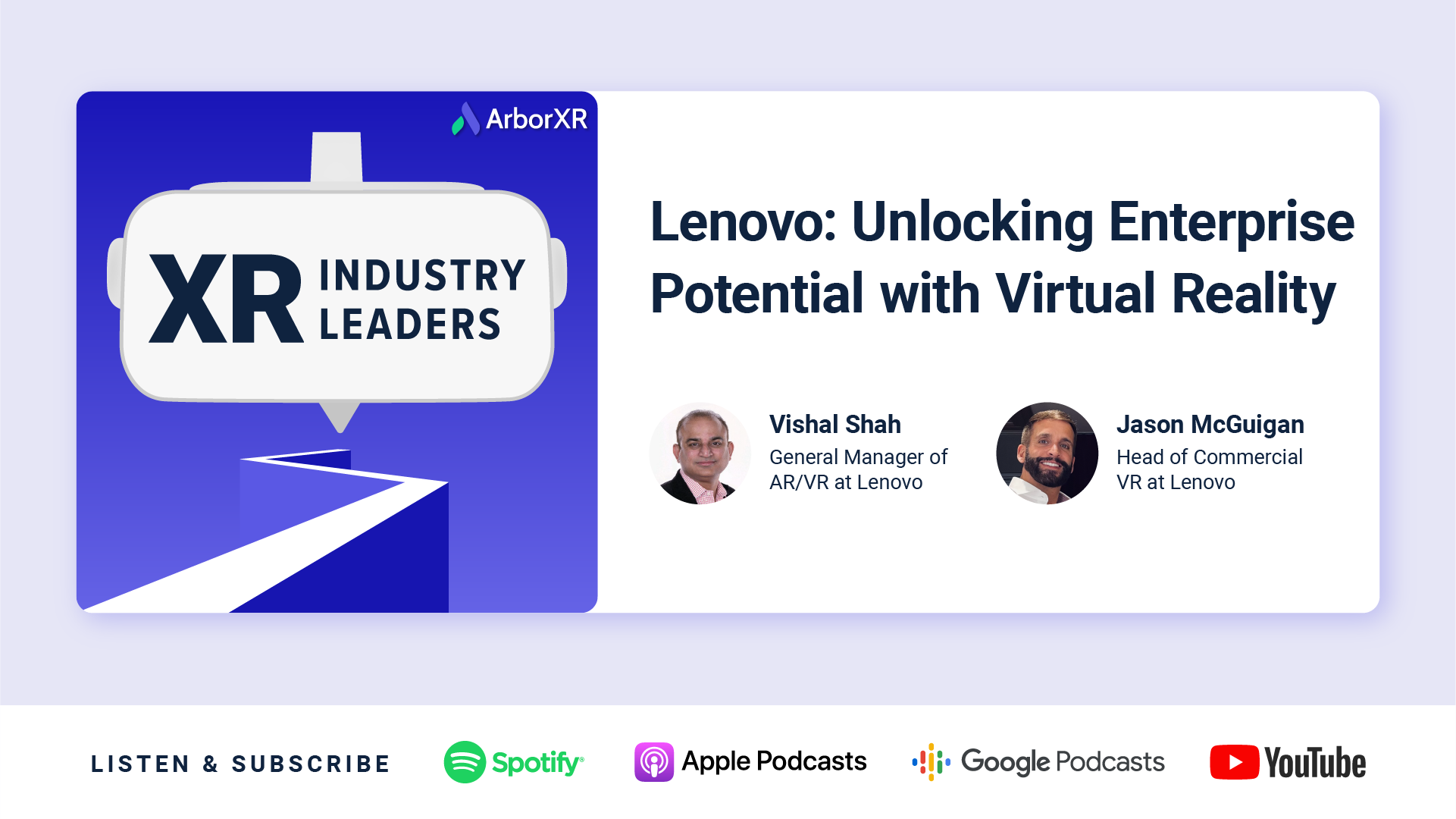
Lenovo: Unlocking Enterprise Potential with VR
Dive into the dynamic world of extended reality (XR) with Lenovo’s Vishal Shah and Jason McGuigan as they unravel Lenovo’s new enterprise XR solution: the Lenovo ThinkReality VRX.

PICO: Practical Enterprise Applications in XR at Scale
Explore XR’s future with PICO’s Amir Khorram in XR Industry Leaders. Insightful discussion on VR enterprise solutions, partnerships, and industry adoption.
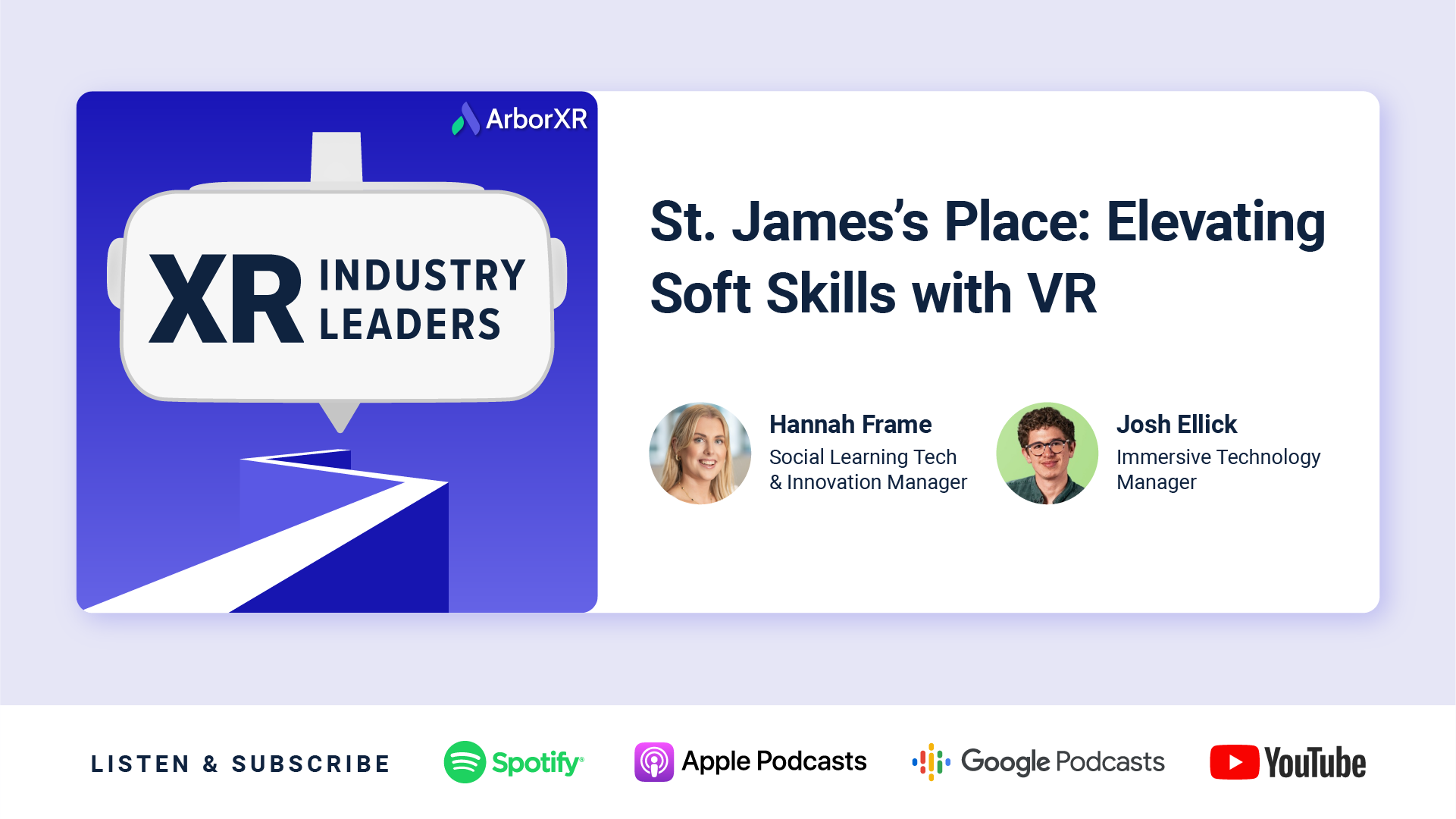
St. James’s Place: Elevating Soft Skills with VR
Hannah & Josh St. James’s Place discuss using VR to train advisor soft skills, challenges of managing headsets at scale, lessons on user adoption, and content development.
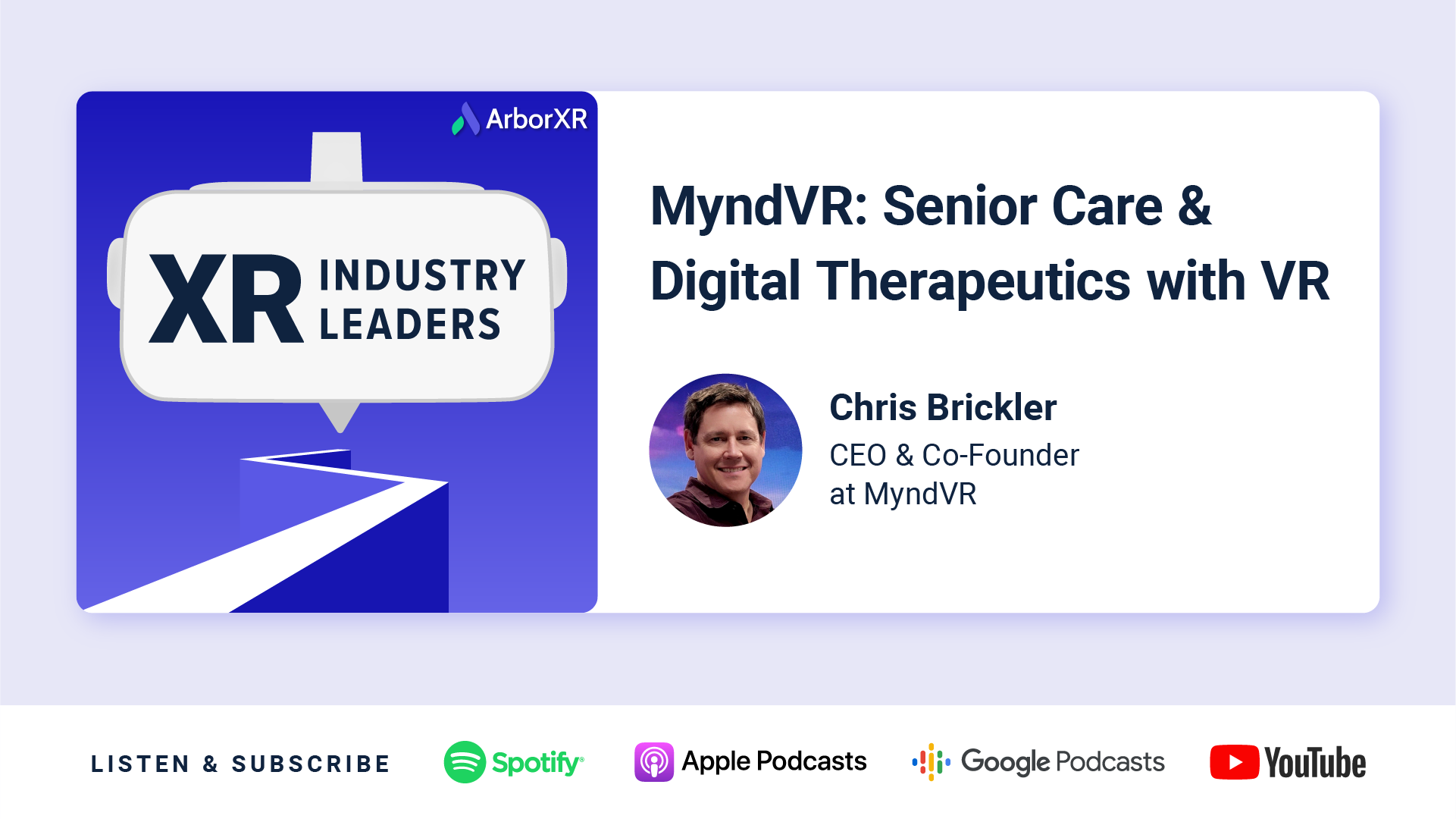
MyndVR: Senior Care and Digital Therapeutics with VR
Chris Brickler shares how VR therapy improves memories and care for elderly patients, and the challenges of scaling VR across health senior care facilities.
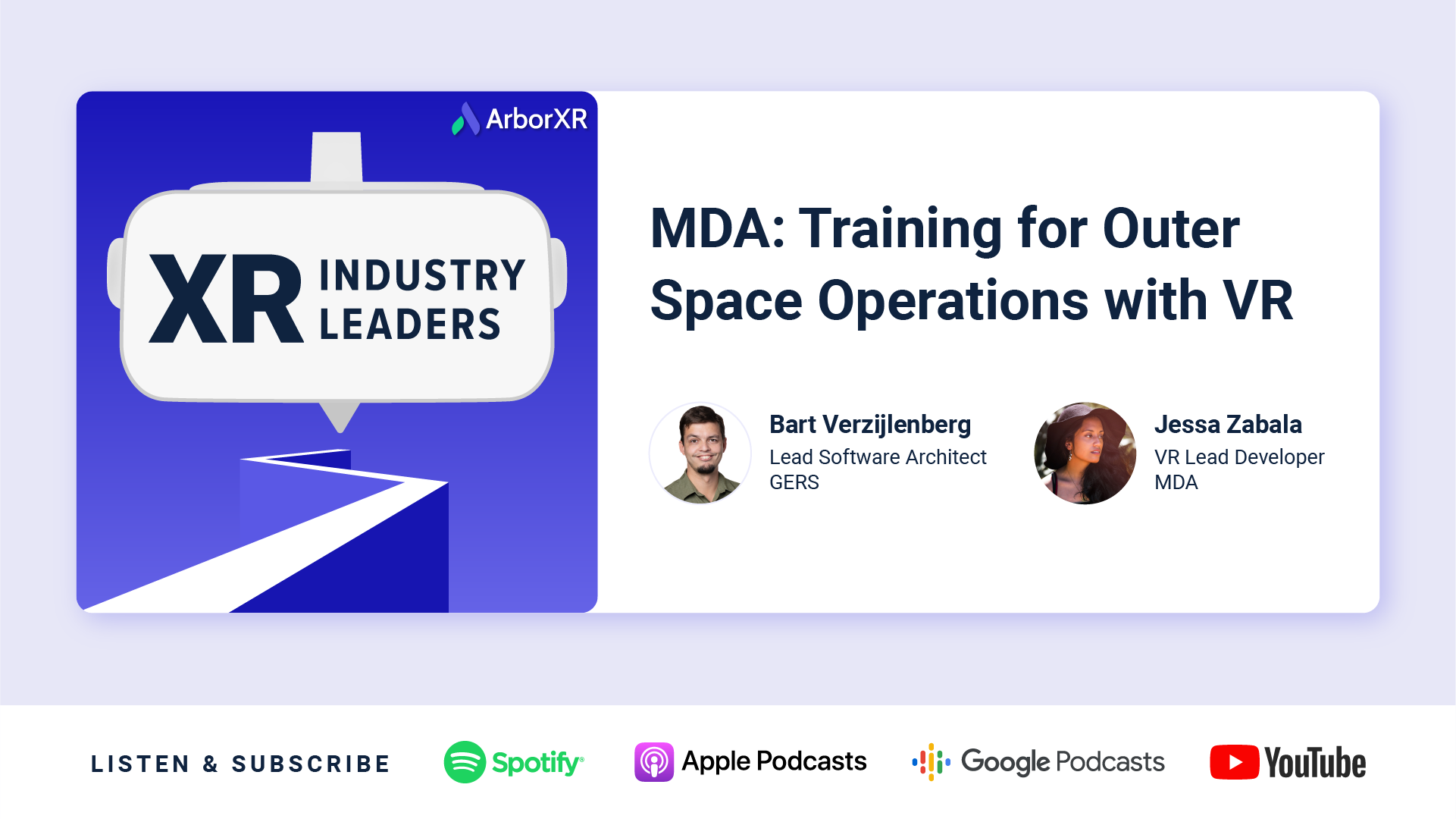
MDA: Training For Outer Space Operations with VR
Discover how MDA leverages VR for astronaut training, mission planning, and onboarding. Gain valuable insights into implementing immersive technologies at scale.

Harvard: Experiential VR Learning in Education
Matt Cook from Harvard joins us to discuss how virtual & augmented reality are redefining higher education through customized immersive experiences.
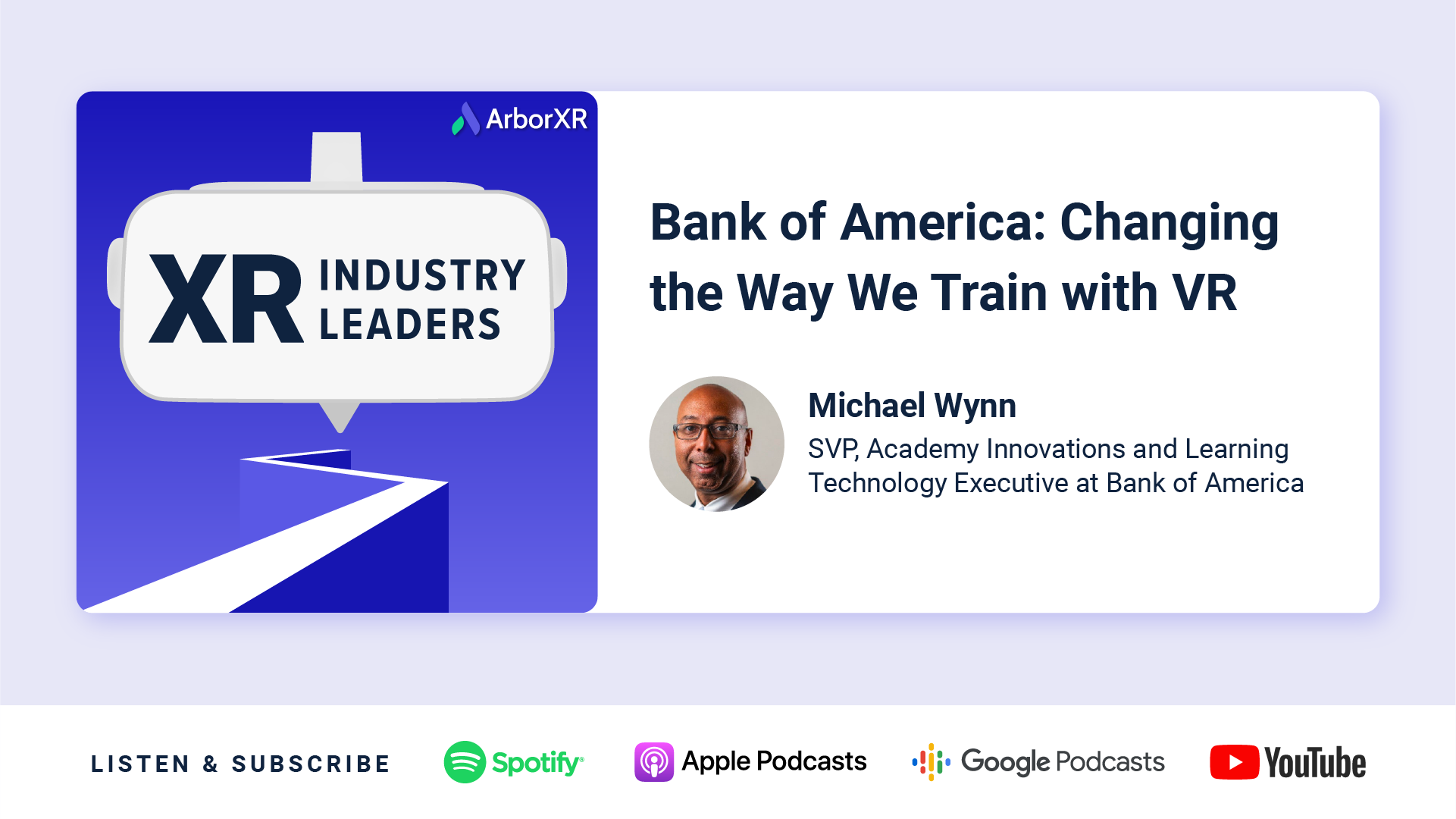
Bank of America: Changing the Way We Train with VR
Explore how Bank of America is revolutionizing training with VR, enhancing employee engagement, overcoming challenges with VR, and redefining corporate education.
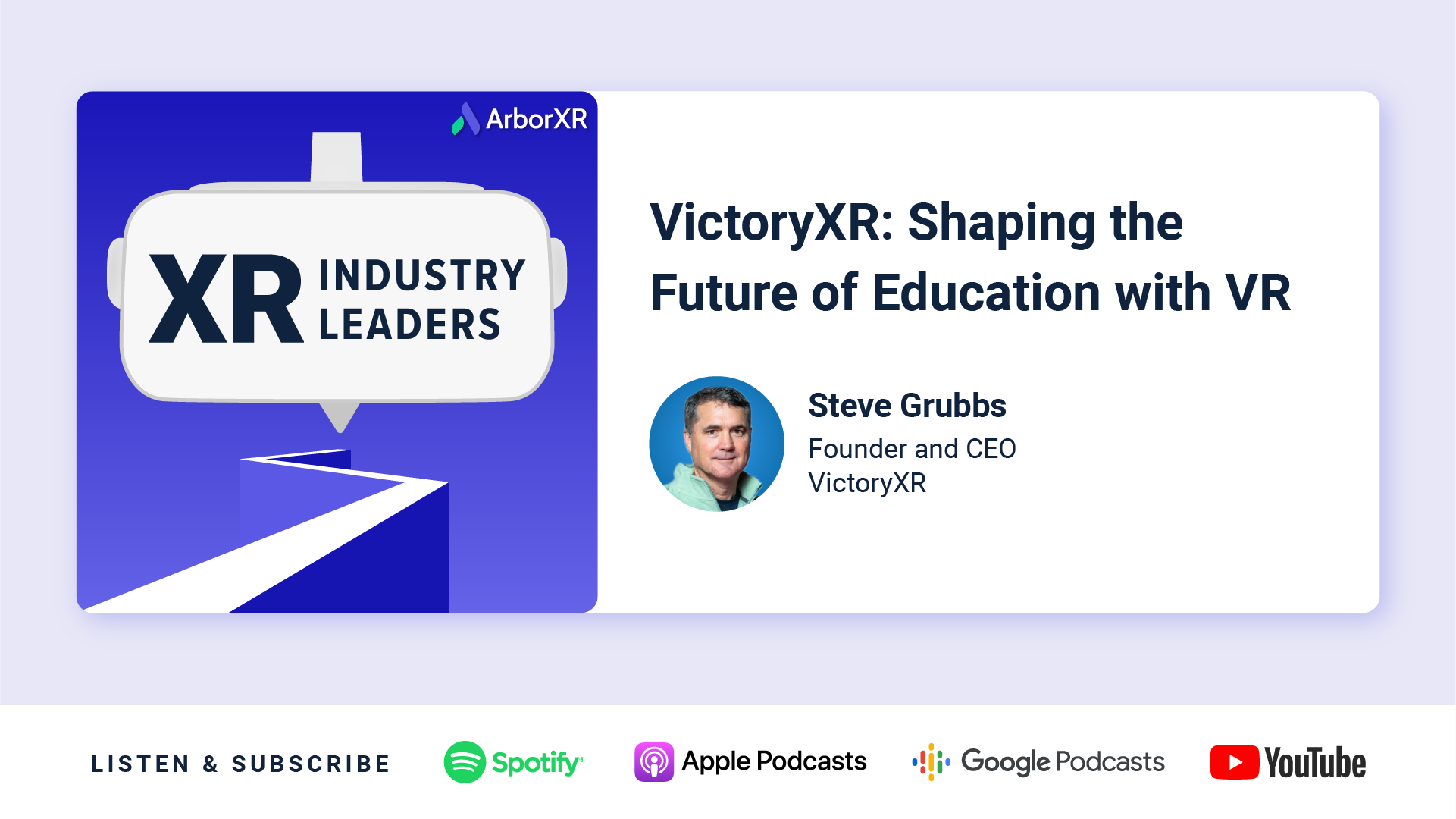
VictoryXR: Shaping the Future of Education with VR
VictoryXR CEO Steve Grubbs discusses creating virtual reality curriculums for education, working closely with Meta, and the future of immersive technology for teachers and students.

VRpatients: Designing Your Own VR Training for Healthcare
Learn how VRpatients creates VR simulations that instructors can customize to give trainees real-life experiences in healthcare.
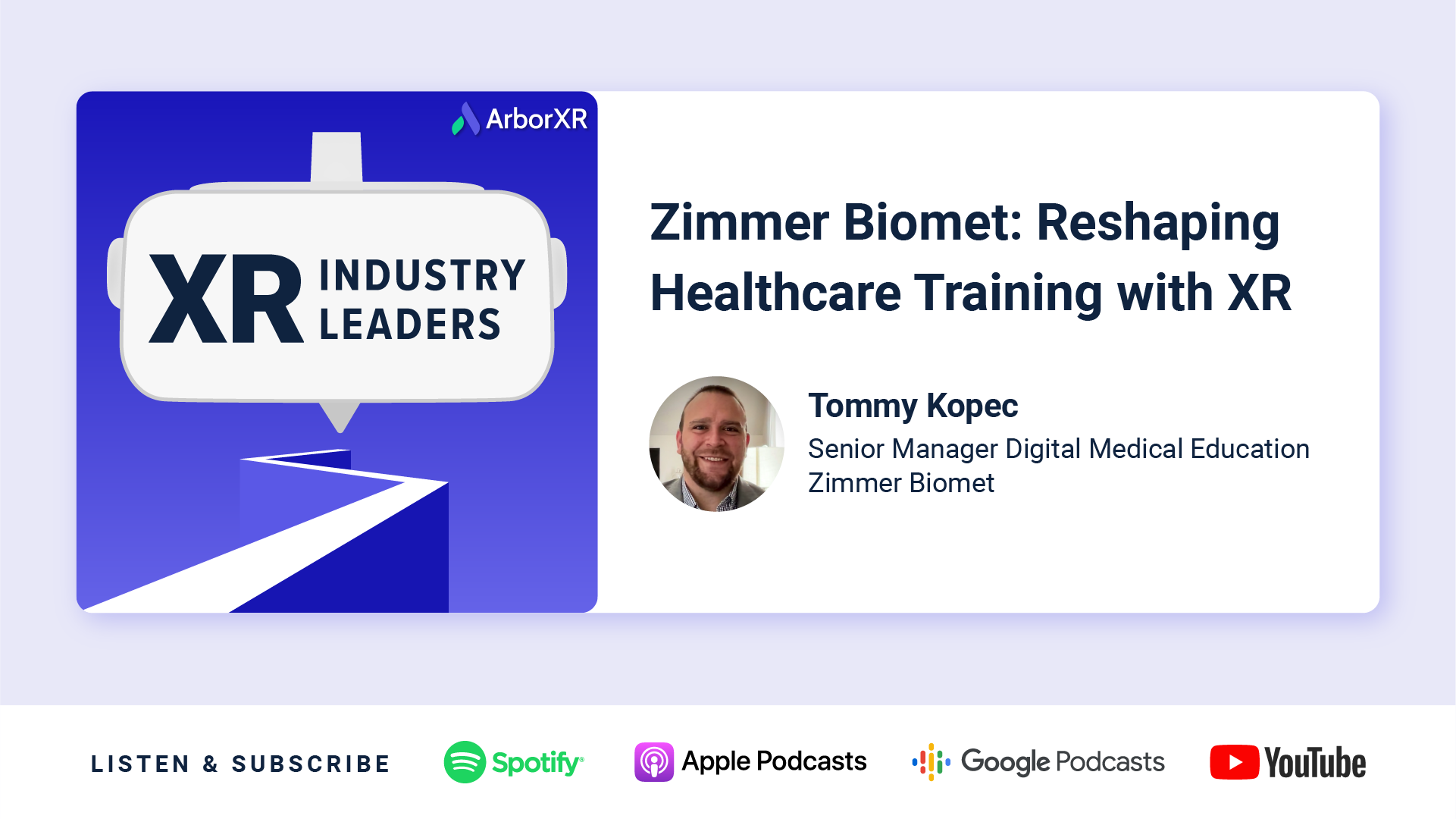
Zimmer Biomet: Reshaping Healthcare Training with AR and VR
If you’re interested in how XR will shape medicine going forward, this is a must-listen episode. Tommy Kopec of Zimmer Biomet provides an insider’s perspective on VR’s transformative potential for surgery, training, and beyond.
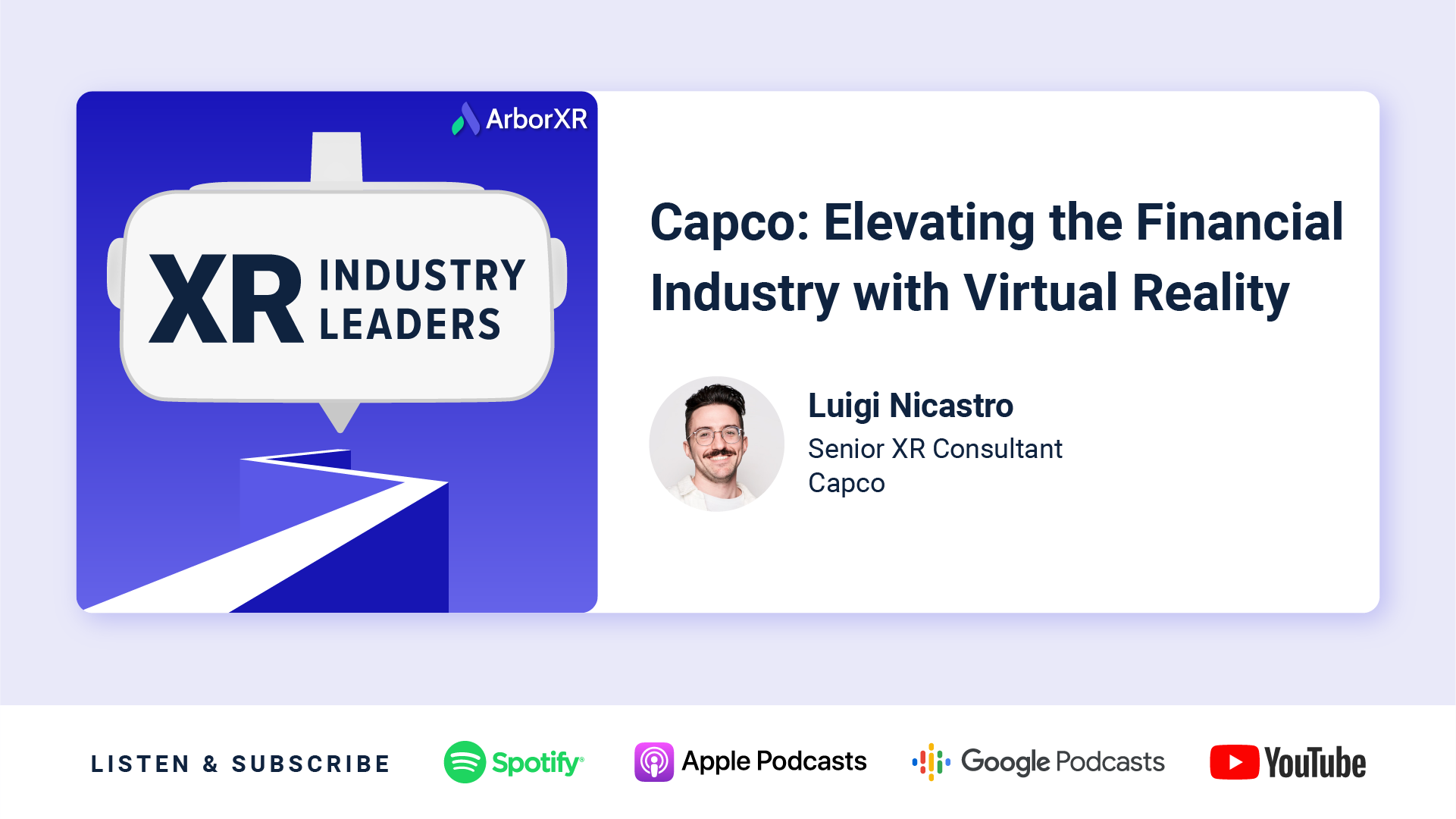
Capco: Elevating the Financial Industry with Virtual Reality
Explore how Capco revolutionizes the financial industry with virtual reality. Discover their success, challenges, and predictions for VR’s impact.

MIT: Exploring Extended Reality in Historic Operas
Discover how MIT uses AR and VR to create immersive experiences for historic operas. We discuss XR in education, challenges and advice for new adopters, and more.

Magic Leap: How Augmented Reality is Elevating Enterprise
Discover how Magic Leap is taking augmented reality to the next level with their enterprise-focused hardware, including real-world statistics and use cases.

Bodyswaps: Innovating Soft Skills Training with Virtual Reality
Discover the future of VR in education with Bodyswaps. Learn how VR elevates soft skills training, and how to implement VR technology effectively.
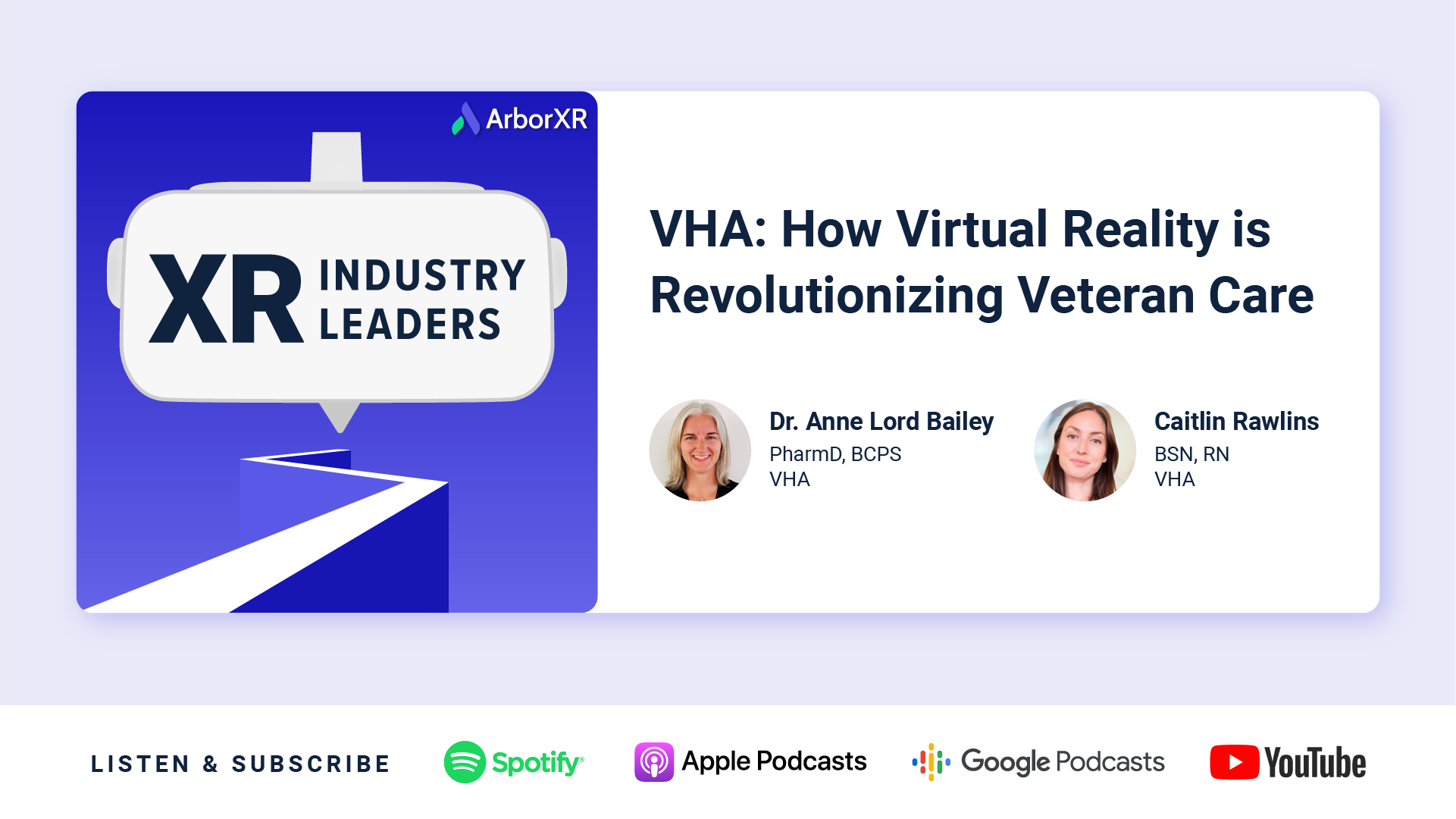
VHA: How Virtual Reality is Revolutionizing Veteran Care
Discover how the VHA is using virtual reality to improve the lives of veterans with pain management, mental health, and overall well-being.
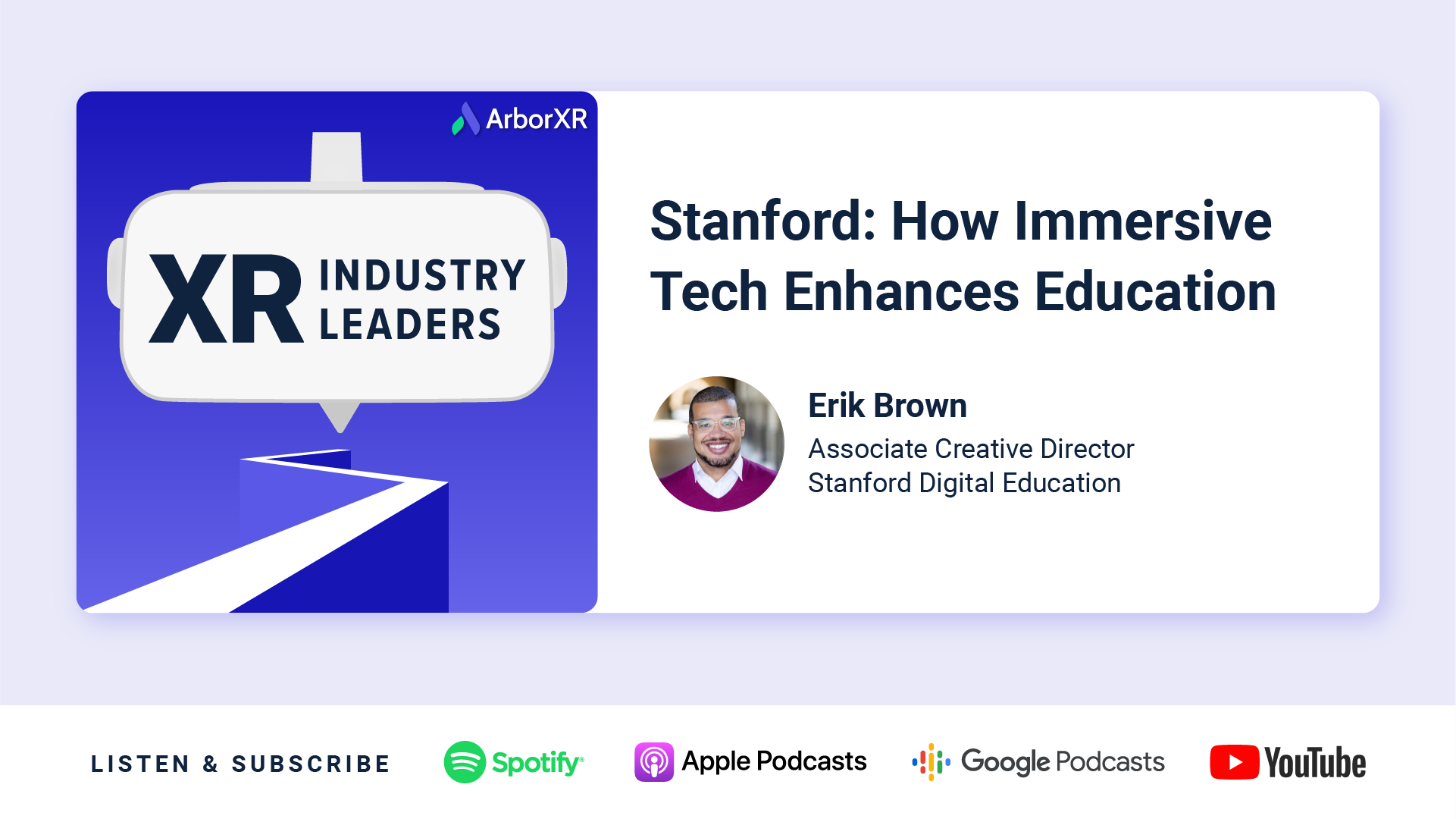
Stanford: How Immersive Technology Enhances Education
Erik Brown discusses how Stanford uses virtual reality for education, empathy in VR, challenges with creating and managing XR content, and more.
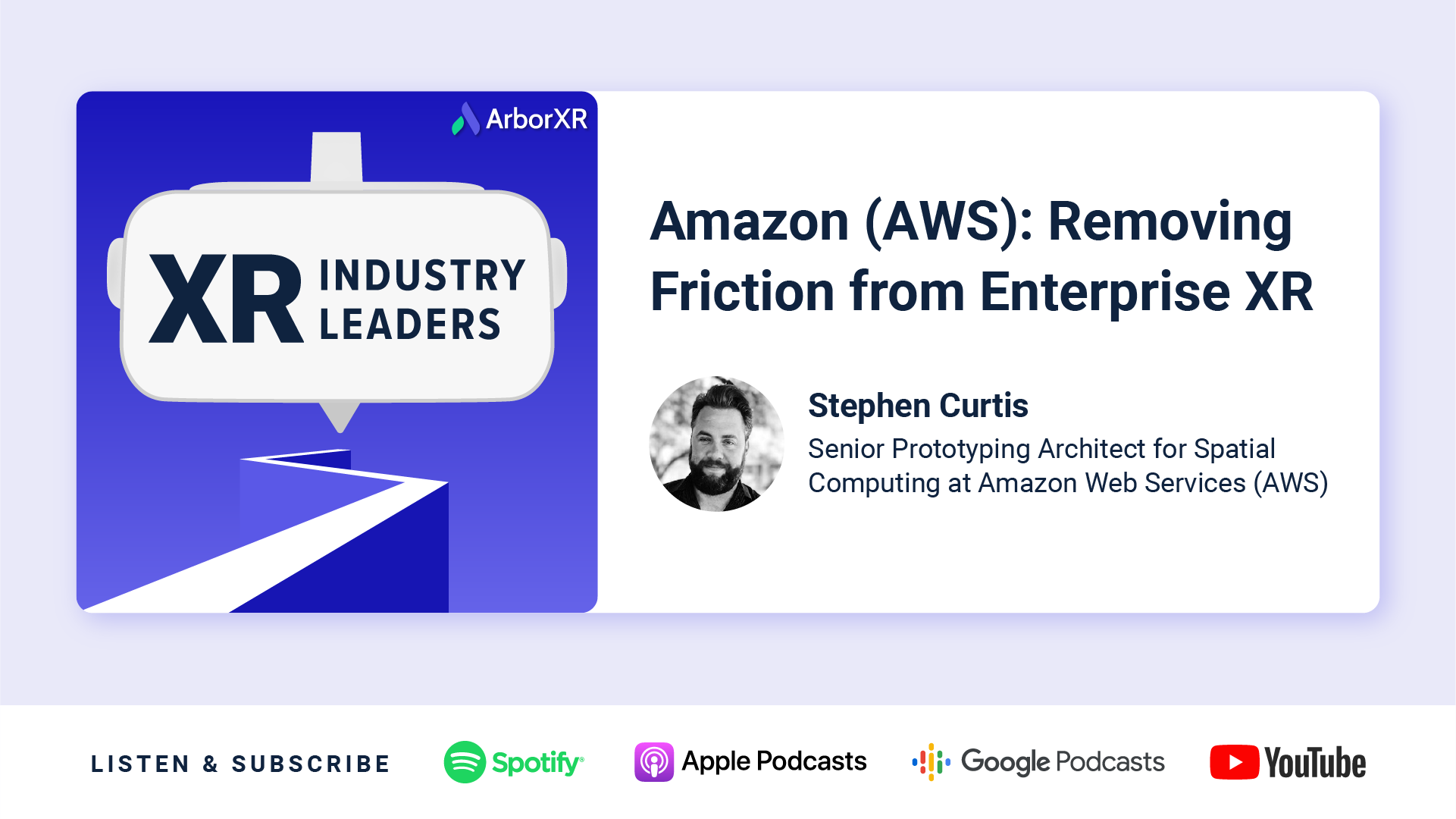
Amazon (AWS): Removing Friction from Enterprise XR
Stephen Curtis from AWS discusses how XR solves enterprise friction, advice for new adopters, XR content authoring, XR device management and more.

WestRock: How XR is Accelerating Manufacturing
XR champion Scott Burkey discusses the impact AR and VR is having on manufacturing, challenges implementing new technology, and advice for using XR in business.

Pfizer: Transforming How We Train with XR
XR leader Nicholas Hockley discusses how XR transformed the way Pfizer trains, challenges with AR/VR content, moving from a pilot program to scale, and more.
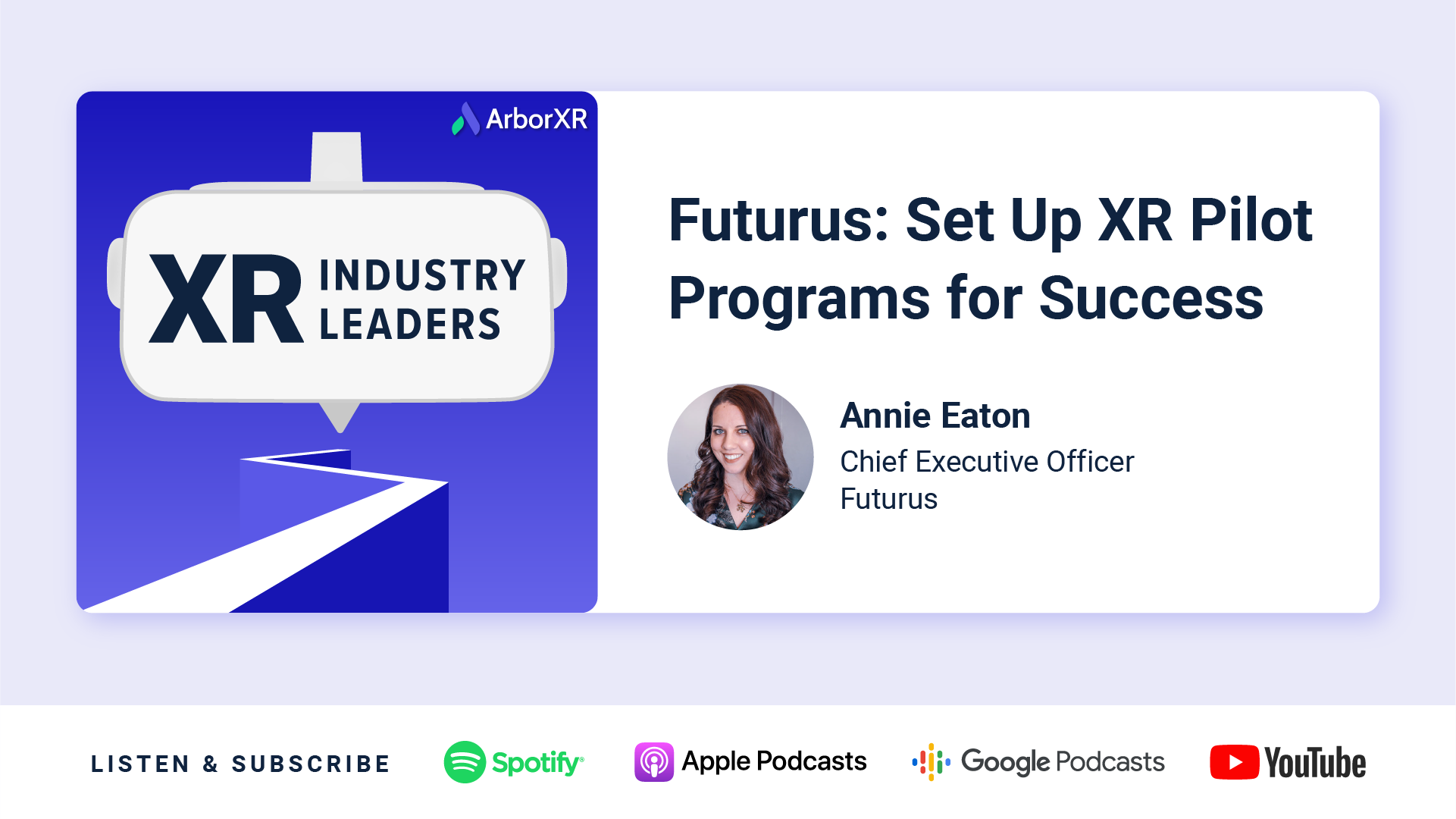
Futurus: Set Up XR Pilot Programs for Success
Futurus CEO Annie Eaton discusses creating AR/VR content, how to set up XR pilot programs for success, challenges in XR, advice for new adopters, and more.
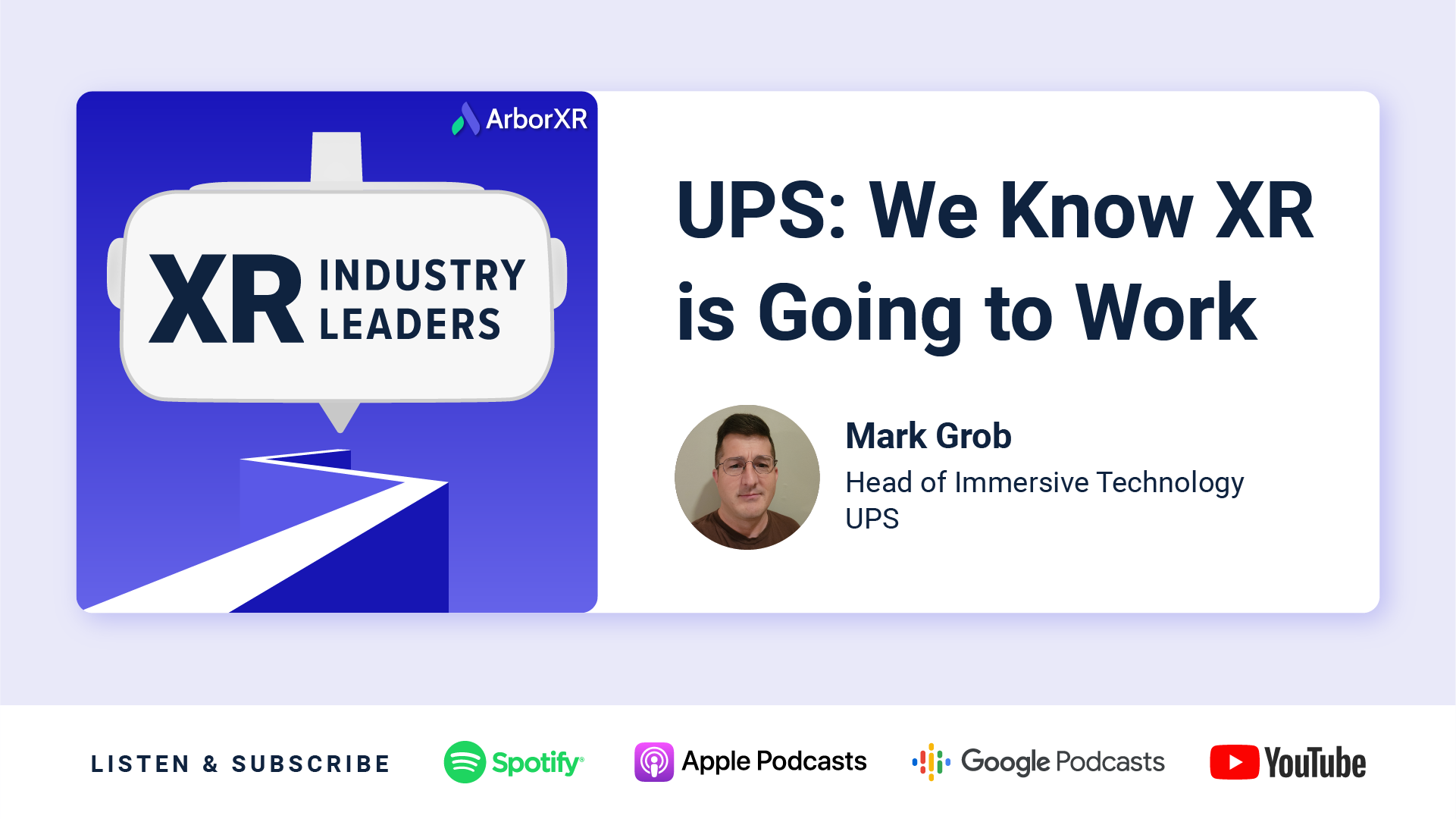
UPS: We Know XR is Going to Work
Learn how UPS built XR training as a practice. We discuss using AR/VR in business, challenges and benefits of XR training, advice for new adopters & more.

INVISTA (Koch Industries): What if We Reimagined Our Entire Training Process?
Learn how XR is transforming INVISTA (Koch). We discuss using AR/VR in business, challenges and benefits of XR training, strategy to scaling XR adoption & more.

Lenovo: Unlocking Enterprise Potential with VR
Dive into the dynamic world of extended reality (XR) with Lenovo’s Vishal Shah and Jason McGuigan as they unravel Lenovo’s new enterprise XR solution: the Lenovo ThinkReality VRX.

PICO: Practical Enterprise Applications in XR at Scale
Explore XR’s future with PICO’s Amir Khorram in XR Industry Leaders. Insightful discussion on VR enterprise solutions, partnerships, and industry adoption.

St. James’s Place: Elevating Soft Skills with VR
Hannah & Josh St. James’s Place discuss using VR to train advisor soft skills, challenges of managing headsets at scale, lessons on user adoption, and content development.

MyndVR: Senior Care and Digital Therapeutics with VR
Chris Brickler shares how VR therapy improves memories and care for elderly patients, and the challenges of scaling VR across health senior care facilities.

MDA: Training For Outer Space Operations with VR
Discover how MDA leverages VR for astronaut training, mission planning, and onboarding. Gain valuable insights into implementing immersive technologies at scale.

Harvard: Experiential VR Learning in Education
Matt Cook from Harvard joins us to discuss how virtual & augmented reality are redefining higher education through customized immersive experiences.

Bank of America: Changing the Way We Train with VR
Explore how Bank of America is revolutionizing training with VR, enhancing employee engagement, overcoming challenges with VR, and redefining corporate education.

VictoryXR: Shaping the Future of Education with VR
VictoryXR CEO Steve Grubbs discusses creating virtual reality curriculums for education, working closely with Meta, and the future of immersive technology for teachers and students.

VRpatients: Designing Your Own VR Training for Healthcare
Learn how VRpatients creates VR simulations that instructors can customize to give trainees real-life experiences in healthcare.

Zimmer Biomet: Reshaping Healthcare Training with AR and VR
If you’re interested in how XR will shape medicine going forward, this is a must-listen episode. Tommy Kopec of Zimmer Biomet provides an insider’s perspective on VR’s transformative potential for surgery, training, and beyond.
